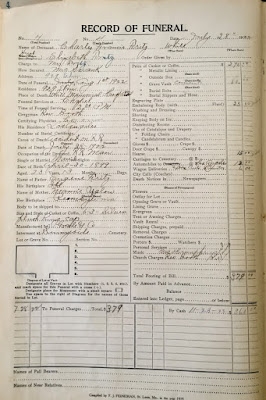CIVIL WAR VETERAN
William F. Hamilton
William F. Hamilton’s gravestone cites his birth year and death year. It also records his service with the 42nd Missouri Volunteer Infantry, in Company G.
photo: QHGS
The medal engraved above his name shows that he belonged to the G.A.R. (Grand Army of the Republic), a fraternal organization of Union veterans.
image: Wikimedia Commons
Note that William’s wife Laura belonged to the W. R. C. (Woman’s Relief Corps). Wikipedia tells us that, “this organization was designed to assist the GAR, promote and help run Memorial Day (alongside the GAR), petition the federal government for nurses pensions, and promote patriotic education.”
To find genealogical information about William—date of birth, date of death—several online databases were visited in the following order:
1. To establish the fact that William F. Hamilton served in the Union Army, we consulted National Park Service, U.S. Civil War Soldiers, 1861-1865 [database on-line]. Provo, UT, USA: Ancestry.com Operations Inc, 2007.
This source provided the following information:
“William F. Hamilton served in the 42nd Regiment, Missouri Infantry, in Company G. He entered the Union Army as a Private and left the service as a Private.”
2. To find out if William was a Civil War pensioner, we looked for him in the National Archives and Records Administration. U.S., Civil War Pension Index: General Index to Pension Files, 1861-1934 [database on-line]. Provo, UT, USA: Ancestry.com Operations Inc, 2000.
This source provided the following information:
“William F. Hamilton filed for a Civil War pension on 23 May 1879 as an Invalid.
3. We examined the California, Death Index, 1905-1939 [database on-line]. Provo, UT, USA: Ancestry.com Operations, Inc., 2013, and found the following information:
“William F. Hamilton, born about 1844, died on 6 May 1937, in Los Angeles county.”
4. Finally, using information from source three, we located a digitized image of William’s death certificate on the FamilySearch® website at California, County Birth and Death Records, 1800-1994, index and images, FamilySearch, Los Angeles, Long Beach > Death certificates 1937 no 401-1742 > image 294 of 1408.
This source provided the following information:
“William F. Hamilton was born on 6 January 1847, in Macomb, Illinois. His father, John C. Hamilton, was born in Ohio, and his mother, Florinda Lloyd, was born in Kentucky. William died, aged 90, of chronic nephritis, on 6 May 1937, at his daughter’s home in Long Beach. He had resided in California and lived in Long Beach for 30 years. William was buried in Sunnyside Cemetery on 8 May 1937, and the mortuary in charge of his interment was Patterson & McQuilkin.”
The four sources cited above create only the barest outline of William F. Hamilton’s life. To find out more about him—to make his story “come alive”—we can use U.S. Census records to trace his journey from Illinois to Missouri to Washington, and thence to Long Beach, California. We can also examine marriage records to find out when and where he married Laura (the 1910 census tells us she was his 3rd wife). Information about the 42nd Regiment Missouri Infantry, is available at
http://42ndmo.webstarts.com/. We can also search Ancestry.com to see if there is information about him in public family trees.
RESEARCH TIP: Don't stop searching for information about Civil War veterans after the “usual” databases have been consulted. Re-numbering and re-filing of veterans’ records occurred several times, and each index card generated may have slightly different information written on it. Look at all of them!



































